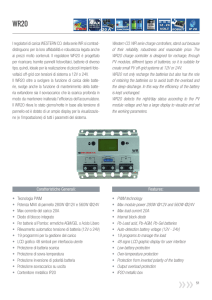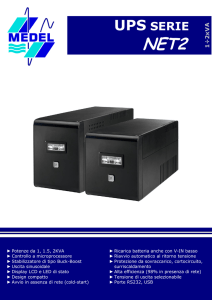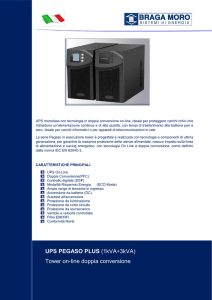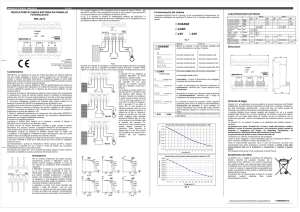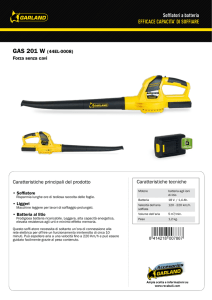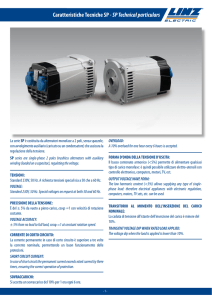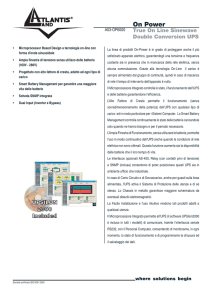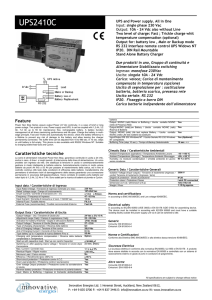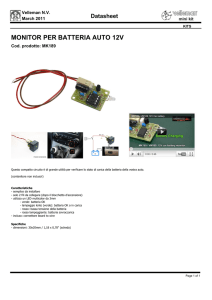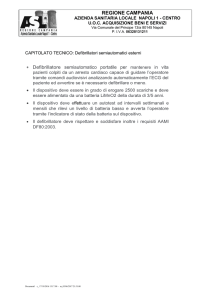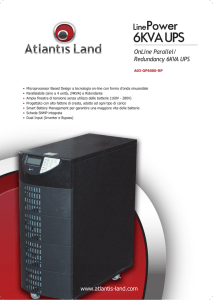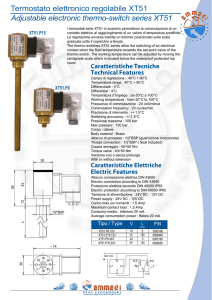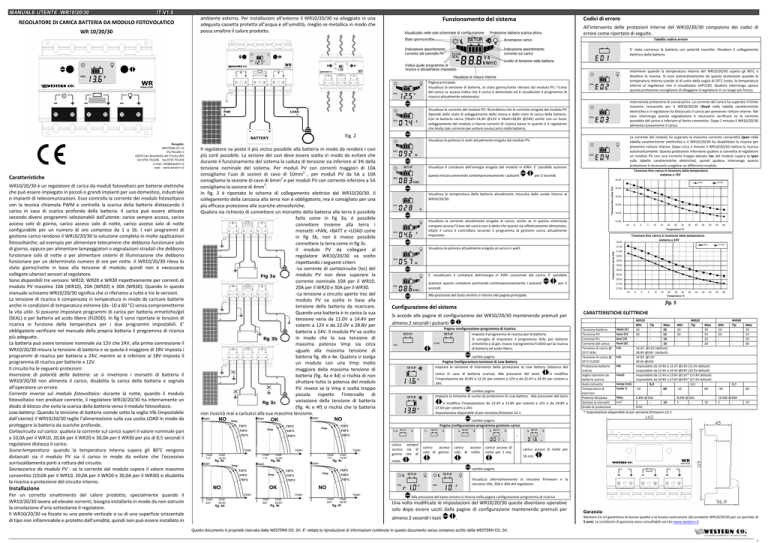
M
M
A
N
U
A
E
U
E
N
E
W
R
MA
AN
NU
UA
ALLLE
EU
UTTTE
EN
NTTTE
EW
WR
R111000///222000///333000
IIITTTV
V
V111...555
REGOLATORE DI CARICA BATTERIA DA MODULO FOTOVOLATICO
WR 10/20/30
ambiente esterno. Per installazioni all’esterno il WR10/20/30 va alloggiato in una
adeguata cassetta protetta all’acqua e all’umidità, meglio se metallica in modo che
possa smaltire il calore prodotto.
Codici di errore
Funzionamento del sistema
Visualizzato nelle sole schermate di configurazione
All’intervento delle protezioni interne del WR10/20/30 compaiono dei codici di
errore come riportato di seguito.
Protezione batteria scarica attiva
Tabella codice errore
Stato giorno/notte
Accensione carico
Indicazione assorbimento
corrente dal pannello PV
Indicazione assorbimento
corrente sul carico
E’ stata connessa la batteria con polarità invertite. Rivedere il collegamento
elettrico della batteria.
Livello di tensione nella batteria
Indica quale programma di
ricarica è attualmente impostato
Interviene quando la temperatura interna del WR10/20/30 supera gli 80°C e
disattiva la ricarica. Si esce automaticamente da questa protezione quando la
temperatura interna scende al di sotto della soglia di 50°C (nota: la temperatura
interna al regolatore non è visualizzata nell’LCD). Qualora intervenga spesso
questa protezione consigliamo di alloggiare il regolatore in un luogo più fresco.
Visualizza le misure interne
Pagina principale.
Visualizza la tensione di batteria, lo stato giorno/notte rilevato dal modulo PV, l’icona
del carico se accesa indica che il carico è alimentato ed è visualizzato il programma di
ricarica attualmente selezionato.
Intervenuta protezione di sovraccarico. La corrente del carico ha superato il limite
massimo consentito per il WR10/20/30 (Iload nella tabella caratteristiche
elettriche) e il regolatore ha distaccato il carico per prevenire rotture interne. Nel
caso intervenga questa segnalazione è necessario verificare se la corrente
assorbita dal carico è inferiore al limite consentito. Dopo 1 minuto il WR10/20/30
alimenta nuovamente il carico.
Visualizza la corrente del modulo PV. Ricordiamo che la corrente erogata dal modulo PV
dipende dallo stato di soleggiamento dello stesso e dallo stato di carica della batteria.
Con la batteria carica (Vbatt>14,4V @12V o Vbatt>28,8V @24V) anche con un buon
soleggiamento del modulo si hanno correnti di ricarica basse in quanto è il regolatore
che limita tale corrente per evitare sovraccarico della batteria.
Fig. 2
La corrente del modulo ha superato la massima corrente consentita (Ipan nella
tabella caratteristiche elettriche) e il WR10/20/30 ha disabilitato la ricarica per
prevenire rotture interne. Dopo circa 1 minuto il WR10/20/30 riattiva la ricarica
automaticamente. Questa protezione interviene qualora si connetta al regolatore
un modulo PV con una corrente troppo elevata (Isc del modulo supera la Ipan
sulla tabella caratteristiche elettriche), quindi qualora intervenga questa
protezione è necessario scegliere un differente modulo.
Visualizza la potenza in watt attualmente erogata dal modulo PV.
WR10/20/30 è un regolatore di carica da moduli fotovoltaici per batterie elettriche
che può essere impiegato in piccoli o grandi impianti per uso domestico, industriale
o impianti di telecomunicazioni. Esso controlla la corrente del modulo fotovoltaico
con la tecnica chiamata PWM e controlla la scarica della batteria distaccando il
carico in caso di scarica profonda della batteria. Il carico può essere attivato
secondo diversi programmi selezionabili dall’utente: carico sempre acceso, carico
acceso solo di giorno, carico acceso solo di notte, carico acceso solo di notte
configurabile per un numero di ore compreso da 1 a 16. I vari programmi di
gestione carico rendono il WR10/20/30 la soluzione completa in molte applicazioni
fotovoltaiche; ad esempio per alimentare telecamere che debbono funzionare solo
di giorno, oppure per alimentare lampeggiatori o segnalazioni stradali che debbono
funzionare solo di notte o per alimentare sistemi di illuminazione che debbono
funzionare per un determinato numero di ore per notte. Il WR10/20/30 rileva lo
stato giorno/notte in base alla tensione di modulo; quindi non è necessario
collegare ulteriori sensori al regolatore.
Sono disponibili tre versioni: WR10, WR20 e WR30 rispettivamente per correnti di
modulo PV massimo 10A (WR10), 20A (WR20) e 30A (WR30). Quando in questo
manuale scriviamo WR10/20/30 significa che ci riferiamo a tutte e tre le versioni.
La tensione di ricarica è compensata in temperatura in modo da caricare batterie
anche in condizioni di temperatura estreme (da -10 a 60 °C) senza comprometterne
la vita utile. Si possono impostare programmi di carica per batteria ermetiche/gel
(SEAL) o per batteria ad acido libero (FLOOD). In fig 5 sono riportate le tensioni di
ricarica in funzione della temperatura per i due programmi impostabili. E’
obbligatorio verificare nel manuale della propria batteria il programma di ricarica
più adeguato.
La batteria può avere tensione nominale sia 12V che 24V; alla prima connessione il
WR10/20/30 misura la tensione di batteria e se questa è maggiore di 18V imposta i
programmi di ricarica per batteria a 24V, mentre se è inferiore ai 18V imposta il
programma di ricarica per batterie a 12V.
Il circuito ha le seguenti protezioni:
Inversione di polarità della batteria: se si invertono i morsetti di batteria il
WR10/20/30 non alimenta il carico, disabilita la carica della batteria e segnala
all’operatore un errore.
Corrente inversa sul modulo fotovoltaico: durante la notte, quando il modulo
fotovoltaico non produce corrente, il regolatore WR10/20/30 ha internamente un
diodo di blocco che evita la scarica della batteria verso il modulo fotovoltaico.
Low-battery: Quando la tensione di batteria scende sotto la soglia Vlb (impostabile
dall’utente) il WR10/20/30 toglie l’alimentazione sulla sua uscita LOAD in modo da
proteggere la batteria da scariche profonde.
Cortocircuito sul carico: qualora la corrente sul carico superi il valore nominale pari
a 10,0A per il WR10, 20,0A per il WR20 e 30,0A per il WR30 per più di 0,5 secondi il
regolatore distacca il carico.
Sovra-temperatura: quando la temperatura interna supera gli 80°C vengono
distaccati sia il modulo PV sia il carico in modo da evitare che l’eccessivo
surriscaldamento porti a rottura del circuito.
Sovraccarico da modulo PV : se la corrente dal modulo supera il valore massimo
consentito (10,0A per il WR10, 20,0A per il WR20 e 30,0A per il WR30) si disabilita
la ricarica a protezione del circuito interno.
T25°C
Vbatt
14.5V
fig. 4a
Ipan
fig. 4b
Vmp
T25°C
T35°C
OK
Vpan
Vbatt
22V
Vbatt
28.8V
fig. 4d
Vbatt
28.8V
fig. 4e
15,00
14,50
14,00
13,50
-10
-5
0
5
10
15
20
25
30
35
40
50
55
60
Tensione fine carica in funzione della temperatura
sistema a 24V
SEAL
31,50
Visualizza la potenza attualmente erogata al carico in watt.
E’ visualizzato il contatore dell’energia in KWh consumati dal carico. E’ possibile
azzerare questo contatore premendo contemporaneamente i pulsanti
secondi.
45
Temperatura °C
32,00
per 2
FLOOD
31,00
30,50
30,00
29,50
29,00
28,50
28,00
27,50
27,00
-10
-5
0
5
Alla pressione del tasto sinistro si ritorna alla pagina principale.
10
15
20
25
30
35
40
45
50
55
60
Temperatura °C
fig. 5
Configurazione del sistema
Si accede alle pagine di configurazione del WR10/20/30 mantenendo premuti per
almeno 2 secondi i pulsanti
.
Pagina configurazione programma di ricarica
Imposta il programma di ricarica per la batteria.
Si consiglia di impostare il programma SEAL per batterie
ermetiche o al gel, invece il programma FLOOD per la ricarica
di batteria ad acido libero.
cambio pagina
Pagina Configurazione tensione di Low Battery
Imposta la tensione di intervento della protezione di Low battery (distacco del
carico in caso di batteria scarica). Alla pressione del tasto
si modifica
l’impostazione da 10.8V a 12.2V per sistemi a 12V e da 21.6V a 24.4V per sistemi a
24V.
cambio pagina
Imposta la tensione di uscita da protezione di Low battery . Alla pressione del tasto
si modifica l’impostazione da 12.4V a 13.8V per sistemi a 12V e da 24.8V a
27.6V per sistemi a 24V.
Impostazione disponibile di per versione firmware ≥2.1
CARATTERISTICHE ELETTRICHE
Tensione batteria
Tensione PV
Corrente PV
Corrente del carico
Tensione di carica @
25°C SEAL
Tensione di carica @
25°C FLOOD
Protezione batteria
scarica
Soglia ripristino da
batteria scarica
Auto consumo
Temperatura di
esercizio
Potenza dissipata
Sezione ai morsetti
Grado di protezione
Vbatt [V]
Vpan [V]
Ipan [A]
Iload [A]
Vch
Vch
Vlb
VexLb
Isleep [mA]
Tamb °C
Pdiss
mm2
WR10
WR20
Min
Tip
Max
Min
Tip
Max
10
35
10
35
20
55
20
55
10
20
10
20
14.4V @12V (default)
28.8V @24V (default)
14.8V @12V
29.6V @24V
impostabile da 10.8V a 12.2V @12V (11.6V default)
impostabile da 21.6V a 24.4V @24V (23.2V default)
impostabile da 12.4V a 13.8V @12V* (13.8V default)
impostabile da 24.8V a 27.6V @24V* (27.6V default)
8,0
8,0
-10
60
-10
60
6.8W @10A
1
IP20
10
8.0W @20A
1
-
10
Min
10
20
-
WR30
Tip
-
Max
35
55
30
30
8,0
.
60
16.0W @30A
1
-
10
-10
* Impostazione disponibile di per versione firmware ≥2.1
cambio pagina
Pagina Configurazione programma gestione carico
carico sempre
acceso sia di
giorno che di
carico
acceso
solo di giorno.
carico
acceso
solo di notte.
carico acceso di
notte per 1 ora.
carico acceso di notte per
16 ore.
notte.
cambio pagina
Visualizza alternativamente la versione firmware e la
versione 10A, 20A e 30A del regolatore.
T55°C
NO
Vpan
Vbatt
22V
Visualizza la corrente attualmente erogata al carico; anche se in questa schermata
compare accesa l’icona del carico non è detto che questo sia effettivamente alimentato,
infatti il carico è controllato secondo il programma di gestione carico attualmente
impostato .
FLOOD
T35°C
T55°C
NO
Visualizza la temperatura della batteria attualmente misurata dalla sonda interna al
WR10/20/30.
T25°C
Vmp
T35°C
T55°C
Vbatt
14.5V
fig. 4c
Ipan
T25°C
Vmp
SEAL
15,50
.
Vpan
Vbatt
11V
Vbatt
14.5V
Ipan
16,00
T55°C
Vpan
Vbatt
11V
Tensione fine carica in funzione della temperatura
sistema a 12V
per 2 secondi.
T35°C
T55°C
Vpan
Vbatt
11V
questa misura premendo contemporaneamente i pulsanti
T25°C
Vmp
T35°C
T55°C
Installazione
Per un corretto smaltimento del calore prodotto, specialmente quando il
WR10/20/30 lavora ad elevate correnti, bisogna installarlo in modo da non ostruire
la circolazione d’aria sottostante il regolatore.
Il WR10/20/30 va fissato su una parete verticale o su di una superficie orizzontale
di tipo non infiammabile e protetto dall’umidità; quindi non può essere installato in
T25°C
Vmp
T35°C
Visualizza il contatore dell’energia erogata dal modulo in KWh. E’ possibile azzerare
Tensione fina carica Volt
Caratteristiche
Il regolatore va posto il più vicino possibile alla batteria in modo da rendere i cavi
più corti possibile. La sezione dei cavi deve essere scelta in modo da evitare che
durante il funzionamento del sistema la caduta di tensione sia inferiore al 3% della
tensione nominale del sistema. Per moduli PV con correnti maggiori di 10A
consigliamo l’uso di sezioni di cavo di 10mm2 , per moduli PV da 5A a 10A
consigliamo la sezione di cavo di 6mm2 e per moduli PV con corrente inferiore a 5A
consigliamo la sezione di 4mm2.
In fig. 2 è riportato lo schema di collegamento elettrico del WR10/20/30. Il
collegamento della carcassa alla terra non è obbligatorio, ma è consigliato per una
più efficace protezione alle scariche atmosferiche.
Qualora sia richiesto di connettere un morsetto della batteria alla terra è possibile
farlo come in fig 3a; é possibile
connettere insieme alla terra i
morsetti +PAN, +BATT e +LOAD come
in fig 3b, non è invece possibile
connettere la terra come in fig 3c.
Il modulo PV da collegare al
regolatore WR10/20/30 va scelto
rispettando i seguenti criteri:
-La corrente di cortocircuito (Isc) del
modulo PV non deve superare la
corrente nominale 10A per il WR10,
20A per il WR20 e 30A per il WR30.
-La tensione a circuito aperto Voc del
modulo PV va scelta in base alla
tensione della batteria da ricaricare.
Quando una batteria è in carica la sua
tensione varia da 11.0V a 14.4V per
sistemi a 12V e da 22.0V a 28.8V per
batteria a 24V. Il modulo PV va scelto
in modo che la sua tensione di
massima potenza Vmp sia circa
uguale alla massima tensione di
batteria fig. 4b e 4e. Qualora si scelga
un modulo con una Vmp molto
maggiore della massima tensione di
batteria (fig. 4a e 4d) si rischia di non
sfruttare tutta la potenza del modulo
PV. Invece se la Vmp è scelta troppo
piccola rispetto l’intervallo di
variazione della tensione di batteria
(fig. 4c e 4f) si rischia che la batteria
non riuscirà mai a caricarsi alla sua massima tensione.
Ipan
Ipan
Ipan
NO Vmp
NO
OK
Tensione fina carica Volt
Recapito:
WESTERN CO. srl
Via Pasubio 1
63074 San Benedetto del Tronto (AP)
tel 0735 751248 fax 0735 751254
e-mail: [email protected]
web: www.western.it
Vpan
Vbatt
22V
Vbatt
28.8V
fig. 4f
Alla pressione del tasto sinistro si ritorna nella pagina configurazione programma di ricarica
Una volta modificate le impostazioni del WR10/20/30 queste diventano operative
solo dopo essere usciti dalla pagine di configurazione mantenendo premuti per
almeno 2 secondi i tasti
.
Garanzia
Western Co srl garantisce la buona qualità e la buona costruzione del prodotto WR10/20/30 per un periodo di
5 anni. Le condizioni di garanzia sono consultabili sul sito www.western.it
Questo documento é proprietà riservata dalla WESTERN CO. Srl. E’ vietata la riproduzione di informazioni contenute in questo documento senza consenso scritto della WESTERN CO. Srl.
1
U
U
S
E
R
M
A
N
U
A
W
R
US
SE
ER
RM
MA
AN
NU
UA
ALLL W
WR
R111000///222000///333000
E
E
N
V
EN
NV
V111...555
a proper box that has to be protected against water and humidity, even better if
the box is metallic so to dissipate the produced heat.
PHOTOVOLTAIC BATTERY CHARGE REGULATOR
System working
Error code
It is displayed only in the configuration screens
WR 10/20/30
Low battery protection is ac tive
Day/night status
Load Power on
Indication of current
absorption from PV
Indication of current
abs orption on the load
When in WR10/20/30 an internal protection occurs, it is displayed the error code
(see table below).
Error code table
You have connected the battery with inverted polarities. Control the wiring.
Voltage level in the battery
It indicates whic h charge
program is actually set
It occurs when internal temperature of WR10/20/30 rises above 80°C. In this case battery charge
is disabled. You comes out automatically from this protection when the temperature drops below
the threshold of 50 ° C (internal temperature is not displayed in the LCD). If this protection occurs
often we suggest to install the WR10/20/30 in a cooler place.
It displays internal measures
Main page.
It shows the battery voltage, the day/night status taken from the PV module. If the load
icon is ON it means that the load is power supplied and you can see the charge program
currently selected.
It occurred the overload protection. The load current has exceeded the maximum limit allowed
for the WR10/20/30 (Iload in table electric feature) and the regulator has disconnected the load
to prevent internal breaking. If you see this message you should check if the current absorbed by
the load is lesser than the permitted limit. After 1 minute the WR10/20/30 power supplies back
the load.
It shows the current of PV module. We remember that the current delivered by the PV
module depends on its state of sun irradiation and on the battery state of charge. In
condition of charged battery (Vbatt>14,4V @12V or Vbatt>28,8V @24V) even with a
good sun irradiation of the module we have low charge currents since the regulator
limits such a current to avoid a battery overcharge.
The PV current has exceeded the maximum allowable current (Iload in table electric feature) and
the regulator has disconnected the PV to prevent internal breaking. After about 1 minute
WR10/20/30 re-activates the charge automatically. You have this protection when you connect to
the regulator a PV module with too high current (Isc of the PV module exceeds Ipan on the table
of electrical features); therefore you must choose a different PV module.
It shows the power in watt actually delivered by the PV module.
WR10/20/30 is a charge regulator from PV modules for electric batteries. It can be
used either in small or in big systems for homes, industries or telecommunication
systems. It controls the PV module current with PWM and the battery discharge by
disconnecting the load in case of deep discharge of the battery. The load can be
activated according to different programs which can be set by the user: load
always ON, load ON only during the day, load ON only during night, load ON only
during night and configurable for a number of hours included from 1 to 16. The
different programs of load management make WR10/20/30 the complete solution
in many PV applications; for example: to power supply video cameras that have to
work only during day, to power supply flashing systems or road signalling systems
that have to work only during night, to power supply lighting systems that have to
work for a specified number of hours per night. WR10/20/30 notes the day/night
status according to the PV module voltage; therefore it is not necessary to connect
further sensors to the regulator.
There are 3 versions: WR10, WR20 and WR30 respectively for PV module currents
of max 10A (WR10), 20A (WR20) and 30A (WR30). In this manual when we write
WR10/20/30 we refere to all versions WR10, WR20 and WR30.
The charge voltage is compensated in temperature so to charge the batteries even
with extreme temperature conditions (from -10 to 60 °C) without compromising
the useful life. You can set charge programs either for GEL/AGM sealed batteries
(SEAL) or for flooded lead acid batteries (FLOOD). In fig. 5 there are the charge
voltages according to the temperature for the two programs that can be set. It is
compulsory to verify in the technical manual of your battery if the charging voltage
is appropriate to the battery.
The battery can have a nominal voltage either 12V or 24V; at its first starting
WR10/20/30 measures the battery voltage and, if it is > of 18V, it sets the charge
program for 24V battery, while if it is < of 18V it sets the charge program for 12V
battery.
The circuit has got the following protections:
Polarity inversion of battery: if you invert the battery terminals, WR10/20/30 does
not power on, it does not power the load and it signals a mistake to the operator.
Revers current on PV modules: during night, when PV module does not produce
current, WR10/20/30 charge regulator has an internal reverse current diode that
avoids the battery discharge towards the PV module.
Low-battery: When battery voltage drops below Vlb threshold (selectable)
WR10/20/30 charge regulator disconnects the load to protect the battery from
deep discharge.
Short-circuit on the load: If the current on load overcomes the nominal value equal
to 10,0 A for WR10, 20,0A for WR20 and 30,0A for WR30 for more than 0,5
seconds, the regulator disconnects the load.
Over-temperature: when the internal temperature overcomes 80°C, both PV
module and load are disconnected so to avoid that excessive over-heating
provokes the breakage of the circuit.
Overload on PV module: if current from PV module overcomes Ipan max the
WR10/20/30 stops the charge current to protect its internal circuit.
T25°C
T25°C
Vmp
T35°C
Vbatt
11V
Vbatt
14.5V
Installation
T25°C
T35°C
For a right heat dissipation you have to install WR10/20/30 so not to obstruct the
movement of air below the regulator, especially when it works at high
temperatures.
WR10/20/30 must be fixed either on a vertical wall or on an horizontal notflammable surface and protected against humidity; therefore it cannot be installed
in outdoor applications. For outdoor applications WR10/20/30 has to be housed in
T55°C
Vpan
Vbatt
28.8V
fig. 4d
Vbatt
28.8V
fig. 4e
15,00
14,50
14,00
13,50
-10
-5
0
5
10
15
20
25
30
35
40
45
50
55
60
Temperature °C
Charge voltage To temperature for 24V battery
32,00
It displays the current actually delivered to the load; even if in this screen there is the
load icon ON, this does not mean that the load is not effectively power supplied. In fact
the load is controlled according to the program of load management which is actually
set.
SEAL
31,50
FLOOD
31,00
It shows the power actually delivered to the load in watt.
30,50
30,00
29,50
29,00
28,50
28,00
27,50
27,00
-10
-5
0
5
10
15
20
25
30
35
40
45
50
55
60
Temperature °C
Here you can see the counter of energy in KWh that have been consumed by the load. It
is possible to reset this counter by pressing at the same time the push-buttons
fig. 5
ELECTRIC FEATURES
for 2 seconds.
When you press the left button you return to the main page.
System configuration
You can access to the configuration pages of WR10/20/30 by pressing for at least 2
seconds the push-buttons
.
Configuration page of charge program
It sets the charge program for the battery.
We advise to set the SEAL program for PB sealed AGM / GEL
batteries, while we advise to set the FLOOD program for
the charge of flooded lead acid batteries.
change of page
Configuration page of Low Battery voltage
It sets the intervention voltage of Low Battery protection
(load disconnection in
case of discharged battery). By pressing the push-button
you modify the
setting from 10.8V to 12.2V for systems @ 12V and from 21.6V to 24.4V for
systems @ 24V.
change of page
It sets the threshold for exit from low battery protection. By pressing the push-
Battery voltage
Module voltage
Module current
Load current
Charge voltage @
25°C SEAL
Charge voltage @
25°C FLOOD
Threshold of low
battery protection
Threshold for exit
from low battery
protection
Self-consumption
Working temperature
Power dissipation
Wiring section
IP box degree
Vbatt [V]
Vpan [V]
Ipan [A]
Iload [A]
Vch
Vch
Vlb
VexLb
Isleep [mA]
Tamb °C
Pdiss
mm2
WR10
WR20
Min
Tip
Max
Min
Tip
Max
10
35
10
35
20
55
20
55
10
20
10
20
14.4V @12V (default)
28.8V @24V (default)
14.8V @12V
29.6V @24V
impostabile da 10.8V a 12.2V @12V (11.6V default)
impostabile da 21.6V a 24.4V @24V (23.2V default)
impostabile da 12.4V a 13.8V @12V* (13.8V default)
impostabile da 24.8V a 27.6V @24V* (27.6V default)
8,0
-10
6.8W @10A
1
IP20
60
10
8,0
-10
8.0W @20A
1
-
60
10
Min
10
20
-
WR30
Tip
-
8,0
-10
.
16.0W @30A
1
-
Max
35
55
30
30
60
10
*This setting is available only for firmware version ≥2.1
Mechanical dimensions
button
you modify the setting from 12.4V to 13.8V for 12V systems, and from
24.8V to 27.6V for 24V systems.
This setting is available only for firmware version ≥2.1
cambio pagina
Configuration page of load management program
.
night.
Load ON only
during
day
Load ON only
during
night
Load ON during
night for 1 hour
.
.
Load ON during night for 16
hours
T25°C
It displays the software version and ampere size of regulator
(10A / 20A / 30A).
T35°C
T55°C
Press left button to go back to the configuration page of charge program.
NO
Vpan
Vbatt
22V
15,50
It displays the temperature of battery that is measured by the internal sensor to
WR10/20/30.
change of page
T55°C
OK
for 2
Vbatt
14.5V
Vmp
T35°C
FLOOD
fig. 4c
T25°C
Vmp
NO
Vbatt
22V
Vbatt
11V
Ipan
Ipan
Vmp
Vpan
Vbatt
14.5V
fig. 4b
to reset such measure by pushing at the same time the push-buttons
seconds
Load always ON
either during day
or
during
T55°C
Vpan
Vbatt
11V
fig. 4a
Ipan
T35°C
T55°C
Vpan
SEAL
16,00
It displays the counter of energy that is delivered from the module in KWh. It is possible
T25°C
Vmp
T35°C
T55°C
Charge voltage To temperature for 12V battery
Charge voltage Volt
Features
The regulator has to be placed as close as possible to the battery so to make the
cables as short as possible. The cables’ section has to be chosen so to avoid that,
during the system working, voltage drop is less than 3% of system nominal voltage.
For PV modules with currents > of 10A we advise the use of cables section of
10mm2 ; for PV modules from 5A to 10A we advise the use of cables section of
6mm2 and for PV modules with current < to 5A we advise the use of cables section
of 4mm2.
In fig. 2 there is the scheme of electric connection of WR10/20/30. The connection
of the case to the ground is not compulsory, but it is advised for a more effective
protection against lightning.
If you have to connect a battery terminal on the ground you can do it as in fig 3a; it
is possible to connect together on
the ground the connectors: +PAN,
+BATT and +LOAD as in fig 3b; on
the contrary, it is not possible to
connect the ground as in fig 3c.
The PV module that has to be
connected with WR10/20/30
regulator, has to be chosen by
respecting the following criteria:
-The short-circuit current (Isc) of
PV module must not overcome
the nominal current of 10A for
WR10, 20A for WR20 and 30A for
WR30.
-The open-circuit voltage (Voc) of
the PV module has to be chosen
according to the voltage of the
battery that has to be charged.
When a battery is in charge its
voltage changes from 11.0V to
14.4V for systems @ 12V and
from 22.0V to 28.8V for battery @
24V. The chosen PV module must
have its maximum power voltage
(Vmp) equal to the maximum
battery voltage (fig. 4b and 4e). If
you choose a module with a Vmp
much greater than the maximum
battery voltage (fig. 4a and 4d)
you risk not to exploit the whole
PV module’s charge. Otherwise if
the chosen Vmp is too small in
comparison with the interval of variation of the battery voltage (fig. 4c and 4f) you
risk that the battery will not be able to charge at its maximum voltage.
Ipan
Ipan
Ipan
NO Vmp
NO
OK
Charge voltage Volt
Address:
WESTERN CO. Srl
Via Pasubio 1
63074 San Benedetto del Tronto (AP) - Italy
tel +39 0735 751248 fax +39 0735 751254
e-mail: [email protected]
web: www.western.it
Vpan
Vbatt
22V
Vbatt
28.8V
fig. 4f
Once you have modified the settings of WR10/20/30 these become operative only
after having left the configuration pages by pressing for at least 2 seconds the
Warranty
Western Co. Srl guarantees the good quality and good manufacture of its own Products obliging itself, during
the warranty period of 5 (five) years. Warranty condictions can be read at www.western.it.
push-buttons
This document is the property of WESTERN CO. Srl. All rights are reserved. Reproduction and use of information contained within this document is forbidden without the written consent of WESTERN CO. Srl.
2

